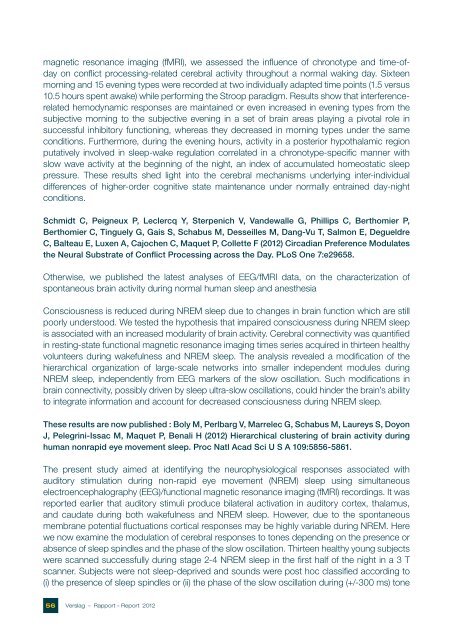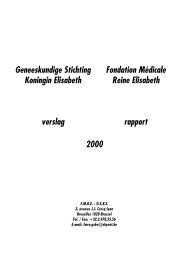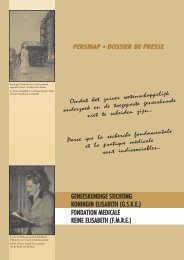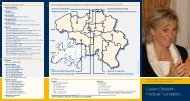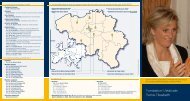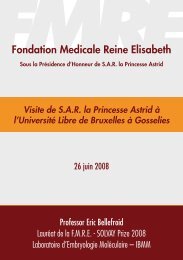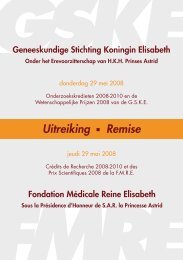Verslag – Rapport – Bericht – Report - GSKE - FMRE
Verslag – Rapport – Bericht – Report - GSKE - FMRE
Verslag – Rapport – Bericht – Report - GSKE - FMRE
You also want an ePaper? Increase the reach of your titles
YUMPU automatically turns print PDFs into web optimized ePapers that Google loves.
magnetic resonance imaging (fMRI), we assessed the influence of chronotype and time-ofday<br />
on conflict processing-related cerebral activity throughout a normal waking day. Sixteen<br />
morning and 15 evening types were recorded at two individually adapted time points (1.5 versus<br />
10.5 hours spent awake) while performing the Stroop paradigm. Results show that interferencerelated<br />
hemodynamic responses are maintained or even increased in evening types from the<br />
subjective morning to the subjective evening in a set of brain areas playing a pivotal role in<br />
successful inhibitory functioning, whereas they decreased in morning types under the same<br />
conditions. Furthermore, during the evening hours, activity in a posterior hypothalamic region<br />
putatively involved in sleep-wake regulation correlated in a chronotype-specific manner with<br />
slow wave activity at the beginning of the night, an index of accumulated homeostatic sleep<br />
pressure. These results shed light into the cerebral mechanisms underlying inter-individual<br />
differences of higher-order cognitive state maintenance under normally entrained day-night<br />
conditions.<br />
Schmidt C, Peigneux P, Leclercq Y, Sterpenich V, Vandewalle G, Phillips C, Berthomier P,<br />
Berthomier C, Tinguely G, Gais S, Schabus M, Desseilles M, Dang-Vu T, Salmon E, Degueldre<br />
C, Balteau E, Luxen A, Cajochen C, Maquet P, Collette F (2012) Circadian Preference Modulates<br />
the Neural Substrate of Conflict Processing across the Day. PLoS One 7:e29658.<br />
Otherwise, we published the latest analyses of EEG/fMRI data, on the characterization of<br />
spontaneous brain activity during normal human sleep and anesthesia<br />
Consciousness is reduced during NREM sleep due to changes in brain function which are still<br />
poorly understood. We tested the hypothesis that impaired consciousness during NREM sleep<br />
is associated with an increased modularity of brain activity. Cerebral connectivity was quantified<br />
in resting-state functional magnetic resonance imaging times series acquired in thirteen healthy<br />
volunteers during wakefulness and NREM sleep. The analysis revealed a modification of the<br />
hierarchical organization of large-scale networks into smaller independent modules during<br />
NREM sleep, independently from EEG markers of the slow oscillation. Such modifications in<br />
brain connectivity, possibly driven by sleep ultra-slow oscillations, could hinder the brain’s ability<br />
to integrate information and account for decreased consciousness during NREM sleep.<br />
These results are now published : Boly M, Perlbarg V, Marrelec G, Schabus M, Laureys S, Doyon<br />
J, Pelegrini-Issac M, Maquet P, Benali H (2012) Hierarchical clustering of brain activity during<br />
human nonrapid eye movement sleep. Proc Natl Acad Sci U S A 109:5856-5861.<br />
The present study aimed at identifying the neurophysiological responses associated with<br />
auditory stimulation during non-rapid eye movement (NREM) sleep using simultaneous<br />
electroencephalography (EEG)/functional magnetic resonance imaging (fMRI) recordings. It was<br />
reported earlier that auditory stimuli produce bilateral activation in auditory cortex, thalamus,<br />
and caudate during both wakefulness and NREM sleep. However, due to the spontaneous<br />
membrane potential fluctuations cortical responses may be highly variable during NREM. Here<br />
we now examine the modulation of cerebral responses to tones depending on the presence or<br />
absence of sleep spindles and the phase of the slow oscillation. Thirteen healthy young subjects<br />
were scanned successfully during stage 2-4 NREM sleep in the first half of the night in a 3 T<br />
scanner. Subjects were not sleep-deprived and sounds were post hoc classified according to<br />
(i) the presence of sleep spindles or (ii) the phase of the slow oscillation during (+/-300 ms) tone<br />
56<br />
<strong>Verslag</strong> <strong>–</strong> <strong>Rapport</strong> <strong>–</strong> <strong>Report</strong> 2012


